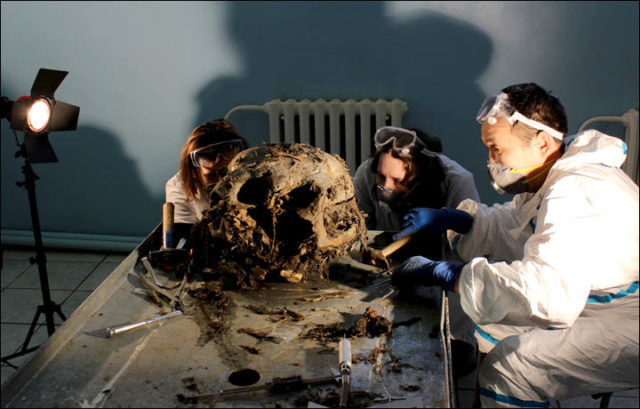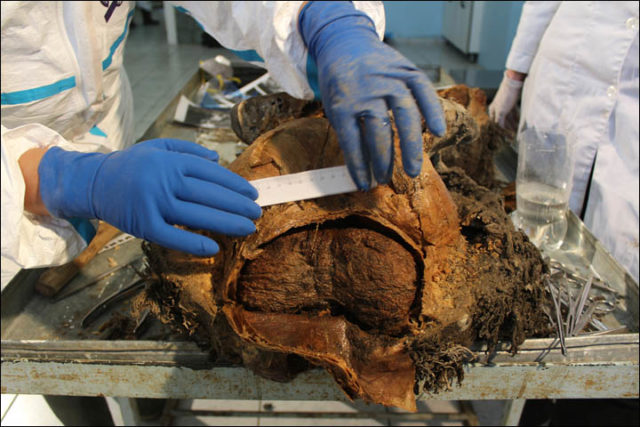The extinct relatives of today’s elephants, wooly mammoths roamed the Earth during the last Ice Age. They were likely the size of modern African elephants but with smaller ears, which they likely kept close to their bodies for warmth. Their tusks were around 15 feet long and were used for fighting and digging in the deep snow. The species were herbivores, eating grass, plants, and flowers.
The exact cause of their extinction is undetermined, but they possibly died out due to a combination of changing food supplies and human hunting. Researchers have learned this information through the discoveries of wooly mammoth remains over time, but there is still much that scientists can learn about the species. They have done this thanks to one special discovery made in 2010 – the excellently preserved remains of a 39,000-year-old wooly mammoth named Yuka, from the Siberian permafrost.

Scientists are analyzing Yuka’s brain as part of a unique study because it is in such good condition. They found the brain in 2012 during an initial CT scan of the cranium performed at Republic of Sakha Academy of Sciences, Yakutsk, to understand the morphology of Yuka’s molars. The research team revealed that the brain had well-defined features such as frontal, temporal, and parietal lobes with gyri and a cerebellum with internal structures. This allowed them to begin work to possibly examine wooly mammoth brain morphology.
In 2013, Yuka’s brain was preserved using a technique developed by Professor Sergei Saveliev of the Research Institute of Human Morphology, Russian Academy of Medical Sciences in Moscow. It involved three weeks of “…continuous preservation of the braincase content using only formalin,” according to researchers. Yuka’s brain was extracted from her remains on February 25, 2013, using the same techniques as for other large animals such as elephants. It was then wrapped with support fabric and placed in formalin solution before being flown to the Research Institute of Human Morphology in Moscow.
Analysis showed that Yuka’s brain has a similar morphology to that of modern elephants, but further studies are needed. Scientists did identify, “…the main functional areas of the brain, making it possible to talk about creating a brain atlas,” said Professor Albert Protopopov. Studies will continue in Moscow at the Institute of Human Morphology under the guidance of Professor Saveliev, who originally preserved Yuka’s brain.
The discovery of Yuka’s brain is incredibly significant for researchers. It is the first time scientists have been able to access a brain in good condition of an animal that lived tens of thousands of years ago. Other wooly mammoth discoveries did not have intact brains due to factors like dehydration, decomposition, or damaged skulls. Research on Yuka’s brain will help scientists to understand the species’ behavior or even potentially recreate the species, Siberian Times reported.
In a separate study, other scientists are aiming to bring the wooly mammoth back to life using modern technology. However, Yuka’s remains do not contain any living cells that would be needed to do this. Scientist Gennady Boeskorov asserted that “we need a living cell for the scientific process organization, but unfortunately, the corpse of Yuka does not contain any. Now, scientists from around the world are working to decipher the DNA of a mammoth. If it is successfully completed, the next step will be a recreation of its similarity and implantation of its nucleus into an elephant cell. Theoretically, it is possible, but practically, no one in the world has been able to carry out such an experiment, which will take a lot of time.”

Research has determined that Yuka was approximately ten years old when she died. Thanks to the efforts of researchers, scientists, and archaeologists she will continue to live on the outside of her former harsh Siberian conditions. Her brain will be further studied and hopefully mapped by scientists, providing knowledge as to the behavior of wooly mammoths.
Perhaps she could even be brought back to life fully in the future. Until then, Yuka’s remains are on tour – kept in a chilled display cabinet, astounding museum visitors around the world in such places as Japan and Taiwan.
